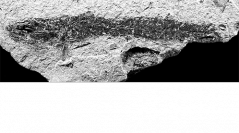

 Geodiversitas
24 (3) - Pages 659-667
Geodiversitas
24 (3) - Pages 659-667Two fossiliferous levels interbedded in the Messinian evaporitic series have been recently discovered in the Molinos de Aguas quarry (Sorbas basin, SE Spain). The older level corresponds to black marls containing fossils fishes of the species Sardina crassa (Sauvage, 1873), when the younger level is a succession of grey marls and limestones with the bivalve Neopycnodonte navicularis (Brocchi, 1814) and the echinoid Brissopsis lyrifera (Forbes,1841). These interruptions of the evaporitic series by marine fossiliferous levels mark two floodings of the eastern part of the Sorbas basin. On a stratigraphical and palaeoenvironmental point of view, these marine facies of Molinos de Aguas are interpreted as the lateral equivalents of two of the three marine fossiliferous facies previously discovered in the evaporitic series of Los Yesos, in the western part of the Sorbas basin: 1) the black marls with fishes of Molinos de Aguas could constitute the equivalent of one of the two black "sands" with oysters and pectinids of Los Yesos ; and 2) the grey marls and limestones with Neopycnodonte and Brissopsis from Molinos de Aguas could be the equivalent of the grey marls and limestones with Neopycnodonte and Brissopsis of Los Yesos.
Messinian, Sardina crassa, Neopycnodonte navicularis, Brissopsis lyrifera, Sorbas, Western Mediterranean, palaeoenvironments, evaporites